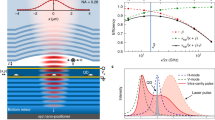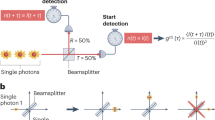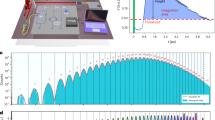Abstract
Single-photon sources have recently been demonstrated using a variety of devices, including molecules1,2,3, mesoscopic quantum wells4, colour centres5, trapped ions6 and semiconductor quantum dots7,8,9,10,11. Compared with a Poisson-distributed source of the same intensity, these sources rarely emit two or more photons in the same pulse. Numerous applications for single-photon sources have been proposed in the field of quantum information, but most—including linear-optical quantum computation12—also require consecutive photons to have identical wave packets. For a source based on a single quantum emitter, the emitter must therefore be excited in a rapid or deterministic way, and interact little with its surrounding environment. Here we test the indistinguishability of photons emitted by a semiconductor quantum dot in a microcavity through a Hong–Ou–Mandel-type two-photon interference experiment13,14. We find that consecutive photons are largely indistinguishable, with a mean wave-packet overlap as large as 0.81, making this source useful in a variety of experiments in quantum optics and quantum information.
This is a preview of subscription content, access via your institution
Access options
Subscribe to this journal
Receive 51 print issues and online access
$199.00 per year
only $3.90 per issue
Buy this article
- Purchase on Springer Link
- Instant access to full article PDF
Prices may be subject to local taxes which are calculated during checkout




Similar content being viewed by others
References
De Martini, F., Di Giuseppe, G. & Marrocco, M. Single-mode generation of quantum photon states by excited single molecules in a microcavity trap. Phys. Rev. Lett. 76, 900–903 (1996)
Brunel, C., Lounis, B., Tamarat, P. & Orrit, M. Triggered source of single photons based on controlled single molecule fluorescence. Phys. Rev. Lett. 83, 2722–2725 (1999)
Lounis, B. & Moerner, W. E. Single photons on demand from a single molecule at room temperature. Nature 407, 491–493 (2000)
Kim, J., Benson, O., Kan, H. & Yamamoto, Y. A single-photon turnstile device. Nature 397, 500–503 (1999)
Beveratos, A. et al. Room temperature stable single-photon source. Eur. Phys. J. D 18, 191–196 (2002)
Kuhn, A., Hennrich, M. & Rempe, G. Deterministic single-photon source for distributed quantum networking. Phys. Rev. Lett. 89, 067901 (2002).
Michler, P. et al. A quantum dot single-photon turnstile device. Science 290, 2282–2285 (2000)
Santori, C., Pelton, M., Solomon, G., Dale, Y. & Yamamoto, Y. Triggered single photons from a quantum dot. Phys. Rev. Lett. 86, 1502–1505 (2001)
Zwiller, V. et al. Single quantum dots emit single photons at a time: antibunching experiments. Appl. Phys. Lett. 78, 2476–2478 (2001)
Yuan, Z. et al. Electrically driven single photon source. Science 295, 102–105 (2002)
Gérard, J.-M. & Gayral, B. Strong Purcell effect for InAs quantum boxes in three-dimensional solid-state microcavities. J. Lightwave Technol. 17, 2089–2095 (1999)
Knill, E., Laflamme, R. & Milburn, G. J. A scheme for efficient quantum computation with linear optics. Nature 409, 46–52 (2001)
Fearn, H. & Loudon, R. Theory of two-photon interference. J. Opt. Soc. Am. B 6, 917–927 (1989)
Hong, C. K., Ou, Z. Y. & Mandel, L. Measurement of subpicosecond time intervals between two photons by interference. Phys. Rev. Lett. 59, 2044–2046 (1987)
Bennett, C. H. & Brassard, G. Proc. IEEE Int. Conf. on Computers, Systems and Signal Processing 175–179 (IEEE, New York, 1984)
Bouwmeester, D., Ekert, A. & Zeilinger, A. The Physics of Quantum Information 49–92 (Springer, Berlin, 2000)
Shih, Y. H. & Alley, C. O. New type of Einstein–Podolsky–Rosen–Bohm experiment using pairs of light quanta produced by optical parametric down conversion. Phys. Rev. Lett. 61, 2921–2924 (1988)
Moreau, E. et al. Single-mode solid-state single photon sources based on isolated quantum dots in pillar microcavities. Appl. Phys. Lett. 79, 2865–2867 (2001)
Solomon, G. S., Pelton, M. & Yamamoto, Y. Single-mode spontaneous emission from a single quantum dot in a three-dimensional microcavity. Phys. Rev. Lett. 86, 3903–3906 (2001)
Borri, P. et al. Ultralong dephasing time in InGaAs quantum dots. Phys. Rev. Lett. 87, 157401 (2001)
Gammon, D., Snow, E. S., Shanabrook, B. V., Katzer, D. S. & Park, D. Homogeneous linewidths in the optical spectrum of a single gallium arsenide quantum dot. Science 273, 87–90 (1996)
Bayer, M. & Forchel, A. Temperature dependence of the exciton homogeneous linewidth in In0.60Ga0.40As/GaAs self-assembled quantum dots. Phys. Rev. B 65, 041308(R) (2002)
Kulakovskii, V. D. et al. Fine structure of biexciton emission in symmetric and asymmetric CdSe/ZnSe single quantum dots. Phys. Rev. Lett. 82, 1780–1783 (1999)
Besombes, L., Kheng, K., Marsal, L. & Mariette, H. Acoustic phonon broadening mechanism in single quantum dot emission. Phys. Rev. B 63, 155307 (2001)
Fan, X., Takagahara, T., Cunningham, J. E. & Wang, H. Pure dephasing induced by exciton–phonon interactions in narrow GaAs quantum wells. Solid State Commun. 108, 857–861 (1998)
Acknowledgements
We thank A. Scherer and T. Yoshie for access to the CAIBE system and for their help in fabrication of the structures; J. Plant for assistance with SEM imaging; and B. C. Sanders for discussions. This work was supported in part by MURI; G.S.S. was supported by DARPA, ARO and JST.
Author information
Authors and Affiliations
Corresponding author
Ethics declarations
Competing interests
The authors declare that they have no competing financial interests.
Rights and permissions
About this article
Cite this article
Santori, C., Fattal, D., Vučković, J. et al. Indistinguishable photons from a single-photon device. Nature 419, 594–597 (2002). https://doi.org/10.1038/nature01086
Received:
Accepted:
Issue Date:
DOI: https://doi.org/10.1038/nature01086
This article is cited by
-
Light–matter interactions in quantum nanophotonic devices
Nature Reviews Physics (2024)
-
Tunable quantum dots in monolithic Fabry-Perot microcavities for high-performance single-photon sources
Light: Science & Applications (2024)
-
Hong–Ou–Mandel interference in colloidal CsPbBr3 perovskite nanocrystals
Nature Photonics (2023)
-
All-silicon quantum light source by embedding an atomic emissive center in a nanophotonic cavity
Nature Communications (2023)
-
Deterministic generation of indistinguishable photons in a cluster state
Nature Photonics (2023)
Comments
By submitting a comment you agree to abide by our Terms and Community Guidelines. If you find something abusive or that does not comply with our terms or guidelines please flag it as inappropriate.



